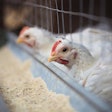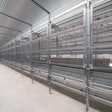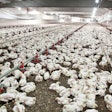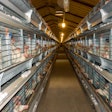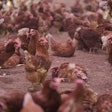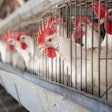In a recent industry presentation, Terry Pollard, vice president of North America sales for Big Dutchman Inc. provided data on the level of current adoption of enriched colony caged systems in the EU. Trends in housing and management in the EU have relevance to the U.S. since welfare activists in this country follow current research and legislative initiatives which they attempt to impose on our Industry. Enriched colony cages were devised in the EU as a method of housing flocks in other than conventional cages without resulting to barn, aviary or free range systems.
At the present, 18 egg-producing nations in the EU with 272 million hens house 13% of their flocks in enriched colony systems.
The approach to alternative housing differs among the major nations with Germany and the UK retaining cages for over half of their flocks as indicated in Table 1. Less than 10% of confined hens are housed in enriched colony cages.
Housing Systems Germany UK
|
Total Hens |
40 million |
30 million |
|
Caged |
57% |
54% |
|
Aviary |
34% |
37% |
|
Enriched Colony |
9% |
9% |
TABLE 1. COMPARSION OF GERMAN & UK HOUSING SYSTEMS
There is considerable variation in the adoption of enriched colony cages among the top nine egg producers as shown in Table 2. The larger nations generally have a lower proportion of their hens in colony cages compared the Nordic countries with numerous small flocks in these systems.
|
Nation |
2009 Hen Population |
Proportion (%) in enriched colony cages |
No. hens (million) in enriched colony cages |
|
France |
47.0 m |
10% |
4.7 |
|
Germany |
38.8m |
9% |
3.5 |
|
Netherlands |
33.3 m |
3% |
1.0 |
|
Sweden |
5.1 m |
39% |
2.0 |
|
Norway |
3.8 m |
29% |
1.1 |
TABLE 2. RANGE IN EU ADOPTION OF ENRICHED COLONY CAGES
The projection of hen populations in various countries of the EU may indicate trends in future exports from Brazil and the U.S. Germany is expected to increase by only 5% in hen population between 2009 and 2012 when the cage-ban is scheduled to take effect. The comparative value for the UK indicated a 20% reduction in hen numbers to 23.5 million with an anticipated ratio of 62% colony or aviary systems to 38% enriched colony housing.
Informal and non-quantitative evaluation of future trends in the U.S. suggests minimal interest in enriched colony cages based on cost relative to floor systems. There is a presumption that enriched colony cages are regarded by opponents of intensive egg production simply as “cages” and this system will be discriminated against despite the apparent ability of hens to stand, turn around and stretch their wings, which appears to be a “standard” applied in voter initiatives.




